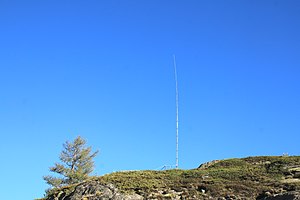Vertical radiator
A vertical radiator is a transmitting antenna that forms a right angle with the earth's surface . It provides vertical polarization . Most transmit antennas for long and medium waves are vertical radiators.
A λ / 4 vertical antenna above a conductive surface (earth) radiates similarly to a linear antenna of length λ / 2 in free space. But it has only half the radiation resistance of a λ / 2 dipole, i.e. about 35 ohms.
In the frequency range of long and medium waves between 150 and 300 kHz, the wavelength λ has values between 1 and 2 kilometers. Technically, you can only work with antennas that are significantly shorter than λ / 4 and are electrically lengthened so that they are in resonance. This adaptation can take place, among other things, through additional inductances at the base of the antenna, or constructively as a roof capacitance .
For frequencies from around 30 MHz, λ / 4 or 5/8-λ emitters can be implemented with reasonable effort. In practice, the radiators are approx. 5% shorter than the theoretical length, as they cannot be made infinitely thin and the diameter is included as an antenna parameter. Thicker emitters also have a larger bandwidth .
Vertical radiators are usually part of a ground plane antenna , where the ground contributes to the radiation.
Web links
literature
- Hans Lobensommer: Handbook of modern radio technology. 1st edition, Franzis Verlag GmbH, Poing 1995, ISBN 3-7723-4262-0
- Alois Krischke: Rothammels Antennenbuch. 11th edition, Franckh-Kosmos-Verlags-GmbH, Stuttgart 1995, ISBN 3-440-07018-2
